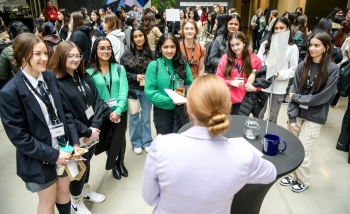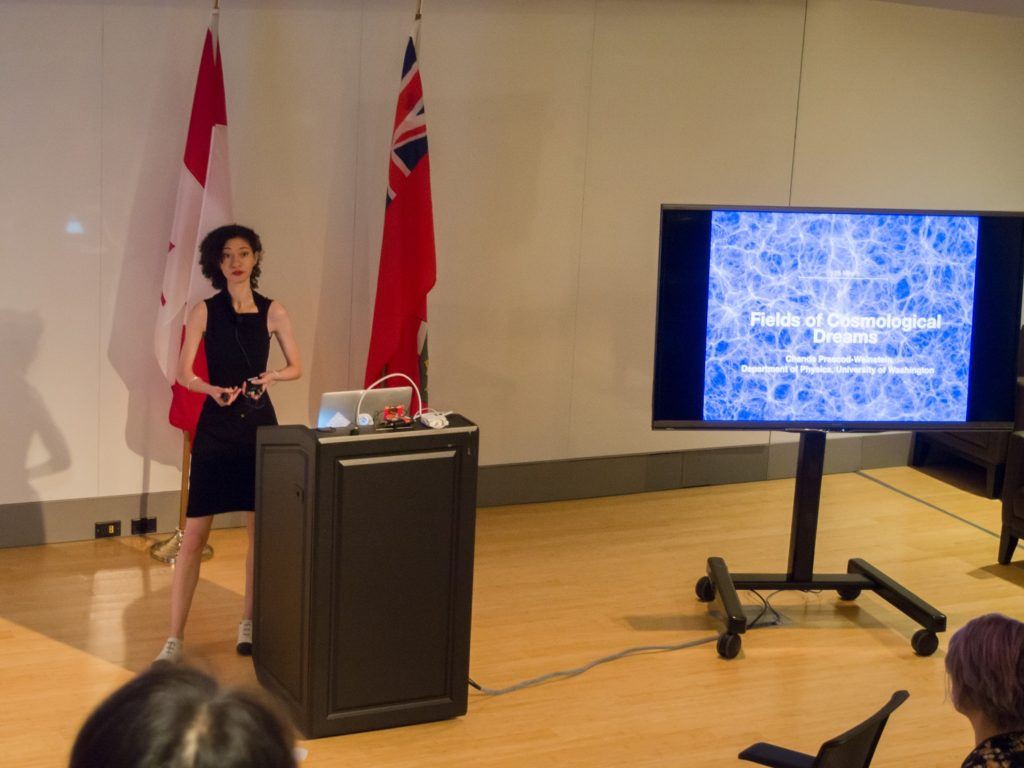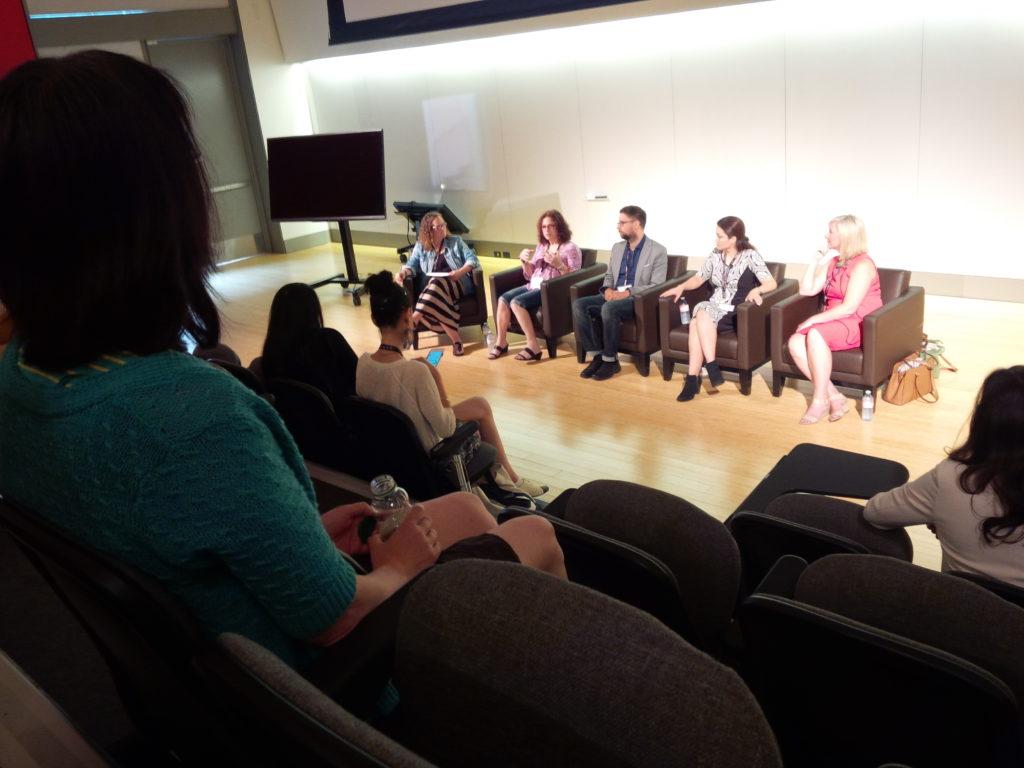Let us take it as given that women have the talent and ability to study physics and pursue research at the highest levels. Let us also take it as given that the vast majority of people would agree with the previous statement.
Is there, then, still a need for the “Women in Physics Canada” conference, held at the Institute for Quantum Computing in Waterloo, Ontario, last week? From discussions held during the three-day gathering of students, postdocs, and professors, it seems the answer is both “yes” and “no.”
Yes, there is a need for women scientists to know the issues they face are not unique nor individual. A legacy of sexism lingers in physics, affecting how students are treated, what people are promoted, how letters of recommendation are written. Even gender-neutral policies can have unintended detrimental impacts on women.
Things start to fray early: data from the US shows a steep drop in women’s participation in physics, starting with the transition from high school (where girls make up half of the enrollment in science and math classes) to university and postgrad (where women make up around 20 percent of physics undergrad and PhD classes). It unravels further when physicists seek tenure: around 16 percent of faculty positions are held by women in the US, but predominantly at the assistant and adjunct professor levels.
On the other hand, no, this is not just a conversation for women. As Serge Villemure, Director of Scholarships and Fellowships at Canada’s Natural Sciences and Engineering Research Council (NSERC), said on the opening day: equity is “not just an issue for those affected by it. It is an issue for everyone. It is a social issue."
Discrimination runs counter to the meritocratic ideal of science itself. If the practice of science largely supports ‘the establishment,’ society risks blocking brilliant thinkers who could make great contributions to the field.
So how, exactly, does one unpick discrimination from the fabric of science?
The case for systemic change
For cosmologist Chanda Prescod-Weinstein, the solution requires systemic change. Encouraging minorities to enter, and stay in, the field will not dismantle the barriers they face; supporting individuals will not ensure others won’t end up needing the same supports.
Cosmologist Chanda Prescod-Weinstein presents her science at Women in Physics Canada 2017.[/caption]
She’s seen it play out in her own career. A respected physicist, Prescod-Weinstein also dedicates time to sitting on committees and promoting equal opportunity in science for all minorities. She sees both her science and her activism as integral to her work, but they are not rewarded equally: she often gets flak for focusing on something other than publishing. “Hiring committees are telling me to stop doing so much additional stuff,” she said during a panel on diversity in science.
Villemure, from NSERC, said it was a common bind. The “publish or perish” mentality that currently dictates success in science does not allow for other modes of work and other priorities, and self-selects for a certain kind of person. “We need to make changes in how excellence in research is defined,” he said.
For example, an idea floated at NSERC is to rely less on lists of publications, and instead ask researchers to highlight their most influential papers and outline other contributions they make to the field, such as mentoring, science and mathematical promotion, outreach activities, and so on.
When being asked whether hiring targets or quotas were the solution, he said they could be considered as part of the solution, along with other measures such as implicit bias training, gendered language awareness building, and breaking down the myth that scientific career paths have to be linear. “Targets and quotas change the culture faster than without them. We need to stop being hesitant. We need to be proactive.”
But affirmative action policies that mandate greater equality are not a panacea. Research suggests that quotas and affirmative action policies have helped white women a lot more than they have helped women of colour. (Indeed, the relative privilege of women among other minorities was a recurring theme throughout the conference. Calls for the gender equality movement to act as an umbrella community for other minorities – such as disabled and trans people, or people of colour – were roundly endorsed by participants.)
“The gap between white women and other women has increased,” said Shohini Ghose, a physics professor at Wilfrid Laurier University and director of the Laurier Centre for Women in Science. “[These policies] are perfectly well intentioned, but they haven’t thought about the fact not every woman is the same.”
There are avenues opening up to promote and enact institutional change. The Athena SWAN network in Britain and related SAGE program in Australia promote gender equality, and award accreditation denoting the level achieved (similar to how the LEED system accredits environmentally friendly construction). These accreditation levels can also be tied to other forms of accountability, such as funding renewals. In Waterloo, Perimeter Institute has implemented a series of initiatives to support women at various stages of career, named after the influential physicist and mathematician Emmy Noether.
But an institute-by-institute approach cannot dismantle the discrimination that, some assert, is enmeshed in the practice of science itself.
Meanwhile, in the classroom...
Gender bias, overt or unconscious, may affect how scientific studies are conducted. A recent article in The Conversation Canada by biologist Thomas Merritt questions whether the predominance of men in science is responsible for the fact that lab studies tend to use male subjects, such as flies, rather than gender-balanced sample groups that provide more meaningful results.
The young women attending WIPC shared their own stories of bias and inequality as they lined up for lunch. Undergraduate students Claire Leuty and Lindsay Babcock said the overwhelming majority of their science and math classmates at the University of Waterloo were male – and that had a tangible impact.
“I feel like, when you are stuck on something and you go ask for help, you’re just perpetuating this idea that girls can’t do math,” Leuty said. And while many of her physics professors actively encourage women to stay in the field, other male professors have been condescending towards female students.
There was, however, an unexpected if somewhat uncomfortable advantage: male first-year undergrads often can’t find older students to help them, because the older, male students were busy helping the first-year females.
“It is creepy, but you’ve got to take advantage of what you have,” Babcock said. “If we’re struggling in other areas because we have disadvantages because we’re female, you might as well take what you can get.”
Their offers of assistance, however, were mostly rebuffed. “When it’s the other way around, when we try to help somebody else, they don’t take us seriously,” Leuty said.
Hidden challenges
Their complaints are not imagined, research shows. While explicit bias has become frowned upon and/or downright illegal in modern society, implicit bias is a harder knot to unravel.
That’s because most people aren’t aware of the internal biases they hold. Implicit bias comes out in unexpected ways: such as associating “science” with one gender and “arts” with another, or labelling one teacher “tough” but the other “mean.”
In her conference presentation, University of Waterloo Centre for Teaching Excellence instructional developer Crystal Tse discussed a study of science faculty members that found faculty favoured male applicants more than female, offering better feedback, more support, and encouraging them to ask for more money in job negotiations. The bias was consistent across male and female faculty.
Such “unseen” biases can leave individuals uncertain of their value or worth. It can be hard to work out if the good or bad things in your career are happening because of your ability, or because of the categories you can be slotted into.
And being aware of a stereotype can lead you to fall prey to it: pressure to disprove a bias can actually impede your ability to do so (something known as stereotype threat). Simply pointing out the reality of implicit bias is not enough to overcome it, Tse warned. “We know from the literature that a lot of diversity training does not work. It actually backfires,” she said.
What is required is not a single element of training, but an ongoing diversity training program such as the University of Michigan’s Diversity, Equity, and Inclusion workshops and its Advance program, that brings the issue to the fore and keeps it top-of-mind.
An individual's choice
Another example of bias could be the decision to schedule a “work-life balance” panel as part of the Women in Physics Canada conference.
Proponents of such panels point out that all people – men and women – juggle the pressures of career, family, and life. Openly discussing these stresses can help people feel less alone, provide coping strategies, and encourage individuals to find whatever kind of “balance” that best suits them.
Opponents, however, counter that such discussions – almost exclusively held during women’s conference or “women’s sessions” at larger gatherings – sustain, rather than address, the academic and societal structures that disadvantage women.
By holding these panels, they say, you imply that the best approach is to “help the women,” rather than addressing the systematic problems that leave people needing such panels. This became a hot and somewhat contentious issue at the conference’s work-life balance panel.
'Work-Life Balance' moderator Jodi Szimanski and panellists (L-R) Joan Vaccaro, Krister Shalm, Razieh Annabestani, and Jen Schrafft discuss work-life balance at WIPC 2017.[/caption]
Whether that means individuals should be responsible for their personal fulfilment was a hot issue at the conference. The debate culminated during the “work-life balance” panel.
One panellist – former IQC postdoc Krister Shalm, who is now a researcher at the US National Institute of Standards and Technology – said people’s unintentional tendency to hire people like themselves had created a field filled with “white, male workaholics.”
“Physics is very macho. We need to really rethink how we work. We can’t do that without greater diversity,” he said. At NIST, he’s trying to help undo the tangle. “I want to hire people that are different from me. They will bring different values and different skills, and will be different kinds of role models,” he said.
Other panellists suggested a more individualistic approach: control what you can, set your own limits, and define your own success. “There’s no right answer. What you want out of your career is going to be your measure of success,” said career coach Jen Schrafft.
Added IQC postdoc and new mom Razieh Annabestani: “Different people have different definitions of ‘work’ and ‘life.’ What helped me a lot was to get away from this reverence of tough competition.”
The discussion illuminated a fraught dichotomy: defining your own measure of success is all well and good for creating a greater level of personal equanimity, but it does not change the prerequisites for a job promotion. You still need to play the game to score a big win.
For Ghose, who was not on the panel, the whole concept of “balance” is misleading. Career success requires dedication and sacrifice. So does a family. Most people wax and wane between the two, she said, often vacillating between extremes, and that is okay. To hold up an arbitrary and often-unachievable ideal of “balance” mostly makes people feel inadequate.
But there’s a deeper problem when these panels are largely directed at women, she warned. “There’s an historical inability to view women apart from their family,” she said. “Historically, men can be seen in just a professional light, but women cannot. These panels hark back to those standards.”
Short term, the panels share stories and strategies for surviving an imperfect system. But survival today won’t dismantle the barriers for minority scientists tomorrow. Much better, said Ghose, would be to disrupt the status quo and create an environment in which “balance” wasn’t a discussion point for anyone.
A woman's place
It could all be enough to leave heads spinning. Thankfully, the attendees were physicists and physics students, who are well accustomed to probing complexity. They finished the three-day conference not dismayed by the issues, but invigorated by the robust discussions.
Physics undergrad Amy McAllister said she’ll be going back to the University of Lethbridge with a renewed sense of purpose. Before now, she shared any apprehensions about her field with friends studying arts.
“Before I came here, it was something that was holding me back,” she said on the final day. “I didn't feel like I could talk to anybody about it. But now I know there are people that are like-minded, it makes me empowered to keep going and pursue my field.”
At the conference’s welcome session, local Member of Parliament Bardish Chagger – herself a science grad from University of Waterloo – set the tone as she looked into the auditorium of women scientists. “One day, this is what I believe our offices and our labs will look like,” she said.
As the event wound up two days later, University of Toronto professor and active conference participant A.W. Peet summed up the prevailing atmosphere in one tweet: “If the students at #WIPC2017 are the future of physics in Canada, I’m in. All in.”
[Note: This story has been updated to clarify the discussions around hiring quotas and work-life balance.]
About PI
Perimeter Institute is the world’s largest research hub devoted to theoretical physics. The independent Institute was founded in 1999 to foster breakthroughs in the fundamental understanding of our universe, from the smallest particles to the entire cosmos. Research at Perimeter is motivated by the understanding that fundamental science advances human knowledge and catalyzes innovation, and that today’s theoretical physics is tomorrow’s technology. Located in the Region of Waterloo, the not-for-profit Institute is a unique public-private endeavour, including the Governments of Ontario and Canada, that enables cutting-edge research, trains the next generation of scientific pioneers, and shares the power of physics through award-winning educational outreach and public engagement.
You might be interested in




